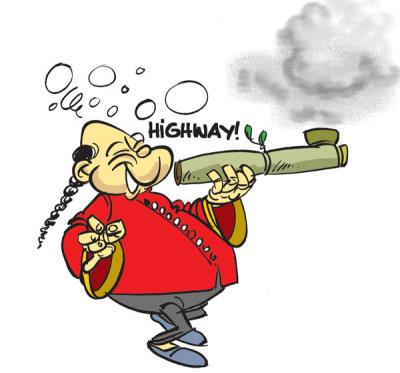The Opium poppy (Papaver somniferum) belongs to the same family as the ‘Coquelicot’ (Papaver rhoeas). The latter is better known as the Flower of Remembrance – when in the 1920’s an American teacher sold silk poppies to friends to raise money for injured service men.
Opium poppy, known since Neolithic times, is known for its medicinal properties. The active ingredient – Morphine, isolated by German Serturner in 1800 – is known to be responsible for reducing intense pain. Known to the Greeks and Romans, it was the Arab merchants who introduced it both in the East and in the West.
The synthetic derivative of Morphine – Heroin – was first isolated in 1874 in Germany and was marketed as a non-addictive substitute to Morphine. It was only in the 1900’s that Americans, trying to get rid of a troublesome cough, realized that their cough remedies were curiously addictive! By 1971, Congress was alarmed that 15% of American servicemen involved in the Vietnam war had become heroin addicts. Recent figures show that Russia has become the largest per capita user of heroin after the return of Soviet soldiers from their war in Afghanistan. However, this is still nothing compared to what the Chinese endured, when they fell under the spell in the early part of the 20th century.
The source of China’s addiction came from the Opium fields in India. The cartels that spread that misery among Indian growers and Chinese consumers were the clandestine representatives of Western Nations including Britain, France and America. Historians even trace the problem back to 1490s when Vasco Da Gama sailed around the Cape of Good Hope and had adopted the view that Africa, India and the East were populated by uncivilized people who could be persuaded to part with the valuable plant species and precious metals in return for cheaper and worthless goods.
While African countries and India were willing to do business, China’s Manchu leaders were proving to be more resistant to trade, as they were quite content with their own goods – porcelain, tea, silks etc. What happened after was quite remarkable in as much as within the next 50 years, the entire social system that had governed China over thousands of years would be brought to its knees by foreign poppies!
This frustration with China made Western nations quite creative in their own trade routes. Britain took control of Bengal’s opium fields after defeating the Indian Mogul in 1757. From there, they ran Opium into China using fast boats. As the ships slipped in and out of Chinese ports, and corrupt Chinese officials continued denying the Opium to their seniors; the East India Company controlled not only the supply but also the price.
Opium of the 18th century was a lucrative business and soon rival supplies were seeping into India from Turkey, France and other places. As more of the stuff flooded in, the price fell and addiction rate rose. The Chinese authorities still resisted by sending Imperial order banning opium consumption but by that time the exposure so great that it began to destabilize every aspect of life in China. Efforts to resist the drug runners were met with gunboat diplomacy. Britain started sending war ships to impose the right to trade. The Chinese were ill equipped and lost the Opium Wars. The aftermath was devastating – the amount of opium flowing into China increased. With farmers struggling to feed people through the debilitating effects of Opium, 1850-1865 witnessed the first insurrection leading to the Taiping Revolution. They seized the land, threw out the private landlords and shared the management of the land with the community.
The weakened Manchu government was compelled to seek outside help to defeat the revolutionaries and enlisted France, USA and Britain who were only too happy to provide logistical and technological aid but at a price – China had to legalise Opium. Reluctantly, China agreed.
Opium addiction had permeated every level of Chinese society and had cost the country its sovereignty. By the end of the 19th century, China was a nation in decline. The last emperor Puyi had abdicated in 1912 and it was not until World War II that China brought this addiction under control.
After World War II, it was the turn of Western countries to bear the brunt of heroin addiction. The Mafia in Italy; the drug cartels in Latin America controlled the trade and by the end of the 20th century – Afghanistan.
PLANTS THAT HAVE MODIFIED THE COURSE OF HISTORY
- Publicité -
EN CONTINU ↻


